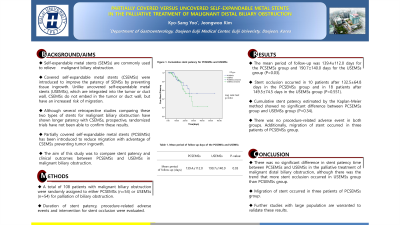Monday Poster Session
Category: Biliary/Pancreas
P1772 - Efficacy of Partially Covered vs Uncovered Self-Expandable Metal Stents in the Palliative Treatment of Malignant Distal Biliary Obstruction
Monday, October 28, 2024
10:30 AM - 4:00 PM ET
Location: Exhibit Hall E

Has Audio
- KY
Kyo-Sang Yoo, MD, PhD
Daejeon Eulji Medical Center
Daejeon, Taejon-jikhalsi, Republic of Korea
Presenting Author(s)
Kyo-Sang Yoo, MD, PhD, Jeongwoo Kim, MD, PhD
Daejeon Eulji Medical Center, Daejeon, Taejon-jikhalsi, Republic of Korea
Introduction: Self-expandable metal stents (SEMSs) are commonly used to relieve malignant biliary obstruction. Covered self-expandable metal stents (CSEMSs) were introduced to improve the patency of SEMSs by preventing tissue ingrowth. Unlike uncovered self-expandable metal stents (USEMSs), which are integrated into the tumor or duct wall, CSEMSs do not embed, but has an increased risk of migration. Although several retrospective studies comparing these two types of stents for malignant biliary obstruction have shown longer patency with CSEMSs, prospective, randomized trials have not been able to confirm these results. Partially covered self-expandable metal stents (PCSEMSs) has been introduced to reduce migration with advantage of CSEMSs preventing tumor ingrowth. The aim of this study was to compare stent patency and clinical outcomes between PCSEMSs and USEMSs in malignant biliary obstruction.
Methods: A total of 108 patients with malignant biliary obstruction were randomly assigned to either PCSEMSs (n=54) or USEMSs (n=54) for palliation of biliary obstruction. Duration of stent patency, procedure-related adverse events and intervention for stent occlusion were evaluated.
Results: The mean period of follow-up was 139.4±112.0 days for the PCSEMSs group and 190.7±140.0 days for the USEMSs group (P=0.03). Stent occlusion occurred in 10 patients after 132.5±64.8 days in the PCSEMSs group and in 18 patients after 149.5±74.5 days in the USEMSs group (P=0.551). Cumulative stent patency estimated by the Kaplan-Meier method showed no significant difference between PCSEMSs group and USEMSs group (P=0.34). There was no procedure-related adverse event in both groups. Additionally, migration of the stent occurred in three patients of PCSEMSs group.
Discussion: There was no significant difference in stent patency time between PCSEMSs and USEMSs in the palliative treatment of malignant distal biliary obstruction, although there was the trend that more stent occlusion occurred in USEMSs group than PCSEMSs group. Migration of PCSEMS occurred in three patients of PCSEMSs group. Further studies with large population are warranted to validate these results.
Disclosures:
Kyo-Sang Yoo, MD, PhD, Jeongwoo Kim, MD, PhD. P1772 - Efficacy of Partially Covered vs Uncovered Self-Expandable Metal Stents in the Palliative Treatment of Malignant Distal Biliary Obstruction, ACG 2024 Annual Scientific Meeting Abstracts. Philadelphia, PA: American College of Gastroenterology.
Daejeon Eulji Medical Center, Daejeon, Taejon-jikhalsi, Republic of Korea
Introduction: Self-expandable metal stents (SEMSs) are commonly used to relieve malignant biliary obstruction. Covered self-expandable metal stents (CSEMSs) were introduced to improve the patency of SEMSs by preventing tissue ingrowth. Unlike uncovered self-expandable metal stents (USEMSs), which are integrated into the tumor or duct wall, CSEMSs do not embed, but has an increased risk of migration. Although several retrospective studies comparing these two types of stents for malignant biliary obstruction have shown longer patency with CSEMSs, prospective, randomized trials have not been able to confirm these results. Partially covered self-expandable metal stents (PCSEMSs) has been introduced to reduce migration with advantage of CSEMSs preventing tumor ingrowth. The aim of this study was to compare stent patency and clinical outcomes between PCSEMSs and USEMSs in malignant biliary obstruction.
Methods: A total of 108 patients with malignant biliary obstruction were randomly assigned to either PCSEMSs (n=54) or USEMSs (n=54) for palliation of biliary obstruction. Duration of stent patency, procedure-related adverse events and intervention for stent occlusion were evaluated.
Results: The mean period of follow-up was 139.4±112.0 days for the PCSEMSs group and 190.7±140.0 days for the USEMSs group (P=0.03). Stent occlusion occurred in 10 patients after 132.5±64.8 days in the PCSEMSs group and in 18 patients after 149.5±74.5 days in the USEMSs group (P=0.551). Cumulative stent patency estimated by the Kaplan-Meier method showed no significant difference between PCSEMSs group and USEMSs group (P=0.34). There was no procedure-related adverse event in both groups. Additionally, migration of the stent occurred in three patients of PCSEMSs group.
Discussion: There was no significant difference in stent patency time between PCSEMSs and USEMSs in the palliative treatment of malignant distal biliary obstruction, although there was the trend that more stent occlusion occurred in USEMSs group than PCSEMSs group. Migration of PCSEMS occurred in three patients of PCSEMSs group. Further studies with large population are warranted to validate these results.
Disclosures:
Kyo-Sang Yoo indicated no relevant financial relationships.
Jeongwoo Kim indicated no relevant financial relationships.
Kyo-Sang Yoo, MD, PhD, Jeongwoo Kim, MD, PhD. P1772 - Efficacy of Partially Covered vs Uncovered Self-Expandable Metal Stents in the Palliative Treatment of Malignant Distal Biliary Obstruction, ACG 2024 Annual Scientific Meeting Abstracts. Philadelphia, PA: American College of Gastroenterology.
